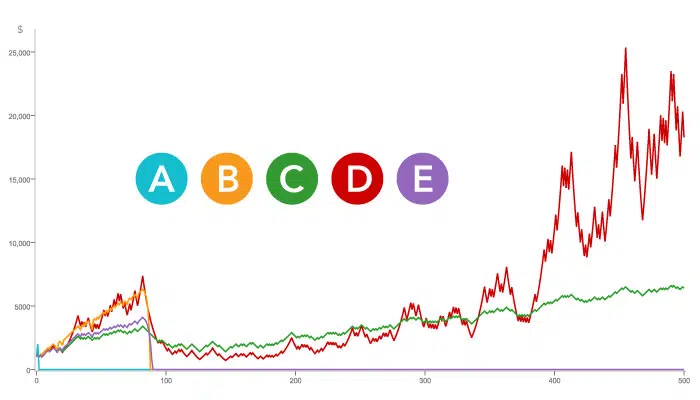In gambling, the amount you bet is just as important as what you bet on. In this article, we simulated five popular betting strategies to try and determine which is the best.
Every serious blackjack player knows that proper playing strategy must be followed in order to keep the house’s edge to a minimum. But staking strategy (i.e. how much to bet on each hand) can be just as important and make the difference between winning and losing in the long run.
The Secret of Success
Mathematician John Kelly Jr. created a staking formula that many professional gamblers follow to this day. Kelly states, “Playing strategy is maybe a third to a quarter … of what you’re going to get out of it. Betting strategy may be two thirds or three quarters”.
Below, we mapped the success of five popular betting systems over a series of 500 bets:

The five betting systems are explained below:
Betting Strategy A: Bet It All, Every Time
Bet your entire balance on each bet. The advantage is that if you win, you win big. The downside, of course, is when you lose, you’re out of money.
Betting Strategy B: Martingale
The Martingale system has you double your bet after every loss, so that the first win would recover all previous losses plus a profit equal to the original bet. Since a gambler with unlimited bankroll will, almost surely, eventually win, the Martingale betting strategy is seen as a sure thing by some.
Of course, no one has an unlimited bankroll, and the exponential growth of the bets in order to cover losses will eventually bankrupt gamblers who use this system.
Betting Strategy C: Fixed Betting
This system requires you bet a fixed amount for each bet. In this example, it is $100. With a 55% probability of winning, this method means you won’t lose your entire balance quickly. It also means any chance of winning will also be slow and steady.
Betting Strategy D: Proportional Betting
With this strategy, you bet a fraction of your balance in proportion to your edge. In this case, we used the Kelly equation for proportional betting. Here your bet would be your edge divided by the odds. In this example, since the edge is 10% and the odds are evens, 10 / 1 is 10.
So 10% of the $1000 balance, i.e. $100, should be bet each time. If that bet wins, the next bet would increase to $110, 10% of the new $1100 wallet. This means winnings increase quicker than in the fixed-wager system, and losses slow down.
Betting Strategy E: Fibonacci
With this strategy, you increase your bet in a Fibonacci sequence, to your losses with the next bet’s winnings. The Fibonacci sequence are numbers in the following sequence:
1, 1, 2, 3, 5, 8, 13, 21, 34, 55, 89, 144,…
By definition, the first two numbers in the Fibonacci sequence are either 1 and 1, or 0 and 1, depending on the chosen starting point of the sequence, and each subsequent number is the sum of the previous two.
This method has similar drawbacks to the Martingale system, but it reduces how quickly the bet increases if you’re on a losing streak,as well as reducing the rate at which you win.
Which Is the Most Profitable Betting Method?
Clearly, Strategy D, the proportional betting system, provides the greatest returns, earning $18,275 after 500 bets. This is not too surprising, since proportional betting appears to have a natural advantage over the others systems.
Say you’re down to your last $100, you’d be betting $10, and decreasing each time, keeping you in the game for much longer than a fixed betting system, where your last $100 would be your last bet.
The only system other than proportional betting to avoid losses was fixed betting (Strategy C), earning $6,400 after 500 bets.
Strategy A, bet it all, generates big gains after the first bet, earning as much in one risk than the others do in the first seven. However, this strategy is eliminated on just the second round. The chance of making it through 500 rounds at 55% is practically impossible – although you would have earned $67 billion by bet 27.
The Martingale (Strategy B) and Fibonacci(Strategy E) betting systems also start strongly, but any big sequence of losses quickly increases the required stake.
In our simulation of betting online, we lost 11 times in a row at round 83. These losses completely wiped out both Fibonacci and Martingale’s stakes. In fact, at the 11-in-a-row loss, the Martingale bettor had to bet $403,000 to recoup his losses.
That was impossible, since his maximum balance was only $6,300. For Fibonacci, the maximum bet was $33,500, with his balance reaching its maximum at $4,100 before busting out.
The 11-bet losing streak also affected proportional betting (Strategy D) greatly, reducing its winnings from $7,359 to $2,286 – lower than that of fixed betting (Strategy C). This shows how well fixed betting protects your winnings and thus ranks as one of our best betting tips.
Which Betting Strategy Should I Choose?
It’s important to keep in mind that our simulation is based on the huge assumptions that we know both the edge (10% in our case) and that the edge is in our favor. This is not likely, and without it, the results for all betting strategies would change significantly.
If you liked this simulation, check out some more betting tips:

